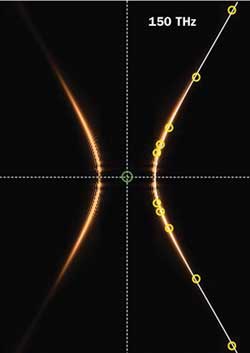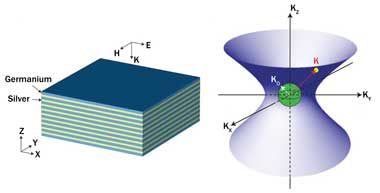
New class of 3-D optical cavities demonstrated
Nanoscale three-dimensional optical cavities made from metamaterials can generate the most powerful nanolaser beams to date.
This new class of optical cavities, with remarkable electromagnetic properties, holds promise for a variety of other technologies, including photonic integrated circuits, LEDs, quantum optics, nonlinear optics and optical sensing.
Optical cavities are the major components of most lasers. Light confined within these cavities reflects back and forth between two opposing mirrors to produce a standing wave at a specific resonant frequency. It is from this standing light wave that a laser beam is generated.

Indefinite optical cavities feature a hyperboloid iso-frequency contour that supports ultrahigh optical refractive indices. This cross section shows the iso-frequency contour (bronze curves) for a silver-germanium metamaterial, with yellow circles representing cavity wave vectors and the green circle representing the light cone of air.
When created from natural materials, optical cavities can be no smaller than the wavelength of the light propagating through them. Metamaterials, however, allow for electromagnetic behavior that is not found in nature. These materials, engineered by combining metals and dielectrics, derive their optical properties from their structure rather than from their chemical composition.
Scientists from the US Department of Energy’s Lawrence Berkeley National Laboratory and the University of California used this information to develop 3-D optical cavities using an “indefinite metamaterial” that alternates superthin multiple layers of germanium and silver.
“Conventional optical cavities are made from natural materials, where the cavity sizes are limited to the wavelength scale due to the restrict refractive indices,” Berkeley Lab principal investigator Xiang Zhang told Photonics Spectra. “Indefinite metamaterials with metal-dielectric multilayers have a hyperbolic spatial dispersion relation, which supports extremely large wave vectors and therefore unnaturally high refractive indices.”

This schematic shows (a) an indefinite metamaterial structure with alternating silver and germanium multilayers and (b) its iso-frequency contour of lightwave vectors with negative refractions along the X- and Y-directions, and positive along the Z-direction.
Light in natural materials behaves the same, no matter the direction in which it propagates. In indefinite metamaterials, however, light can be bent backward in some directions, a property known as negative refraction. Using this indefinite metamaterial enabled the researchers to scale down the 3-D optical cavities to extremely deep subwavelength size, resulting in a “hyperboloid iso-frequency contour” of light wave vectors that support the highest optical refractive indices ever reported.
“By using such metamaterials with refractive indices as high as 17.4, 3-D optical cavities smaller than one-tenth of the optical wavelength have been demonstrated, based on the total internal reflection at the interface of the metamaterial and the surrounding air,” Zhang said. “These optical cavities can compress the optical mode in a tiny space and enhance light-matter interactions.”
Using indefinite metamaterials to make 3-D optical cavities is also advantageous because they offer more flexibility in cavity design, according to Xiaodong Yang, lead author of the paper who is now with the Missouri University of Science and Technology. Cavities of different sizes can have the same resonance frequency. Another advantage is that the number of photons lost when light is reflected back and forth – a problem for optical cavities from natural materials – is reduced as the cavity size gets smaller. This could benefit the design of future nanoscale lasers, Yang said.
The Berkeley team used the dielectric germanium to fabricate its metamaterial because it has a relatively high refractive index (about 4), compared with air (1), which is the dielectric most typically used to make a metamaterial. They alternated layers of 20-nm-thick silver and 30-nm-thick germanium that were cut into various size cubes, depending on the number of metal-dielectric layers. The cube walls tilted into the shape of a trapezoid during the final stage of fabrication, with a nanosize optical cavity in the core.
“Silver and germanium are one combination for the multilayer deposition, since germanium has high surface energy and there is a very smooth wetting effect for the silver growth,” Zhang said. “Other dielectric materials can also be considered with silver, such as glass, magnesium fluoride, titanium oxide. Other combinations such as gold and alumina can also be used.”
Nanoscale lasers and LEDs
All of the material combinations could result in properties similar to those demonstrated by the team’s germanium and silver indefinite metamaterial, he said. The research was reported in Nature Photonics (doi:10.1038/nphoton.2012.124).
The team plans to continue work on applications based on these 3-D optical cavities.
“These optical cavities with truly nanoscale mode sizes can increase the photon density of states and greatly enhance light-matter interactions in lots of optical processes,” Zhang said. “We think the most immediate application will be nanoscale lasers and LEDs. Due to the deep subwavelength mode volumes, these cavities made of alternating layers of metal and semiconductor gain medium can emit light at the nanoscale with an extremely low threshold.”
The team thinks that the application most affected by this technology will be the subwavelength photonic integrated circuits. “The ultrahigh refractive indices supported in the indefinite metamaterials will help to shrink the footprint of the optical components such as cavities, waveguides, beamsplitters, so as to realize photonic integrated circuits with dimensions less than one wavelength.”
The scientists also hope to push the cavity sizes into extremely small nanometer dimensions with a carefully controlled deposition process for the ultrathin metal-dielectric multilayers, Zhang said.
“Practically, the sizes are limited by the available thickness of the multilayers. For example, as we predicted in the paper, cavities smaller than 1/45 of the optical wavelength can be realized with multilayers of 4-nm silver and 6-nm germanium at the wavelength of 2 µm. Such ultrathin-film deposition has been demonstrated with an annealing process.
“There will be more new applications when the cavity sizes go to nanometer level,” he said. “For example, it will be quite interesting to see how a single quantum dot will strongly couple to an optical cavity with the same size as the quantum dot.”
Published: September 2012